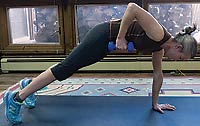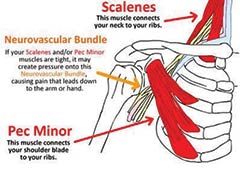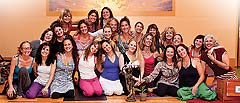|
|
HEALTHY HAPPENING May 2018
|
What is “Sports-General” Training? |
Although you may not be familiar with the phrase, “sports-general” training, you have probably heard of functional training and functional strength. Functional strength means being strong in the movements and positions used in sports and life. To gain these abilities, the body must be trained the way it is used in sports. However, this does not mean you have to do sports-specific training, according to Michael Boyle, the strength and conditioning pioneer who coined the phrase “sports-general” training. Boyle explains that there is a misconception that functional training means doing movements that mimic your sport. In actuality, functional training focuses on the five basic human movements:
- rotational and spiral
- pulling
- pushing
- single-leg
- bend-and-lift
These movements are consistent across sports and activities of daily living. Because these commonalities cross sports, similar functional training movements can be used by each athlete, from a hiker to an extreme skier.
Functional strength and movement come from a stable and aligned posture. When you are in a good position, your muscles can produce the most power, your joints have full range of motion, and you move with ease and grace. Unfortunately, athletes of all levels tend to lack function and alignment. You can be dysfunctionally strong and participate in sports at a high level, but this will be short-lived, as it was for me. The body cannot endure compensation and dysfunction in combination with the extreme demands of sports for long, as Pete Egoscue, founder of the Egoscue Method® for posture alignment points out:
Elite athletes can be dysfunctional. Talent, skill and ability in a specific sport by a specific individual can overcome and make up for many dysfunctions. In fact, many of the sports gifted athletes are incredibly dysfunctional. Their bodies have developed sports specific compensations. Unfortunately, physical performance does not tolerate dysfunction. That is why, over time, so many athletes lose their skills and/or end up playing in pain.
To enjoy an extended, pain-free athletic career, and perform the necessary movements of daily life, you must be functionally strong.
Ready to learn “sports-general” training, and take your functional strength to the next level?
Join Jessica Kisiel, certified posture coach, strength and conditioning specialist and former professional mountain biker for a workout: Posture Conditioning Circuit, Wednesdays, May 23-June 27 from 5:30-6:30 pm. Concepts from the Egoscue Method® and Postural Restoration Institute® will be used. Special attention will be given to the core, hips and pelvis, which create the foundation of aligned posture and work together as the power center for movement. Exercises will challenge participants to correctly activate muscles together in coordinated movements that are synchronized with proper breathing patterns. Class size will be limited to ensure individual instruction. Orientation to the circuit is required prior to participation. Free orientations for those seriously interested attending the workouts will be held the first two Wednesdays of May - 5/2 and 5/9 - from 5:30-6:30 pm at the Moab Recreation and Aquatics Center.
Jessica Kisiel, MS, is a local wellness professional offering posture classes and individual therapy.
|
Why do I have numbness in my arms or hands? There may be several reasons. |
One common cause is called thoracic outlet syndrome (TOS) - an area to the side of your neck where nerves and blood vessels may become compressed between neck muscles, the collar bone, and the first rib. This can cause pain in your shoulders and neck and numbness all the way down to your fingers.
Common reasons why you may develop TOS are linked to repetitive job requirements involving prolonged restricted postures such as carrying heavy shoulder loads, pulling shoulders back and down working on an assembly line, or reaching above shoulder level for work or sports. Sometimes the cause cannot be determined but symptoms can be treated, or modifications can be discussed for activities that may contribute to your symptoms.
Only neurogenic (the most common) TOS will be discussed, meaning your likely cause is a nerve or bundle of nerves being compressed. The bundle of nerves known as the brachial plexus originates in your spinal cord and branches out into your shoulder, forearm, and hands. I won’t go into detail on presentation of symptoms since each person will very based on where the compression occurs. A licensed physical therapist can perform specific tests to determine the likely source and treat your individual symptoms to restore neural communication into the ‘numb’ area. Here is a list of commons neurogenic symptoms you may experience.
Signs and Symptoms of Neurological TOS include:
• Muscle wasting in your hand near the thumb
• Numbness or tingling in your arm or fingers
• Pain or aches in your neck, shoulder or hand
• Weakening grip
After a full examination, including special tests for your specific symptoms, we can begin skilled physical therapy treatment. In some cases, you will be referred back to your primary doctor for additional imaging to help confirm TOS or help guide further treatment. As a physical therapy provider, we can address your postural weaknesses, work station ergonomics, and provide nerve glide stretches to reduce symptoms. Let us help reduce compression of the nerve and improve shoulder girdle strength to avoid permanent damage to compressed structures. If you feel you may be suffering from thoracic outlet syndrome speak to your physician about symptoms or schedule a physical therapy exam. Questions can be emailed to info@moabphysicatherapy.com or call (435)210-1985 to schedule an appointment, we look forward to hearing from you. Follow us on Instagram @moabpt for videos and tips.
|
Anxiety
|
Anxiety is the work of a strong, healthy brain that’s a little overprotective. It comes from a part of the brain called the amygdala, which keeps us safe by getting us ready to fight for our lives or run for it. The amygdala is instinctive, so if it thinks there might be danger, it will act first and think later – and the unfamiliar, the unknown, humiliation, embarrassment, separation from important people, can all count as danger. When the amygdala is triggered, it initiates a surge of neurochemicals to make us stronger, faster, more powerful, and more physically able to deal with a threat. Sometimes, the amygdala can work a little too hard and hit the alarm button too often when it doesn’t need to. .png)
Back when the threats we humans faced were mostly physical, the most anxious of us probably would have been the most likely to survive. An anxious brain would have made us more alive to any threats, which would give us the survival edge. Now, the dangers we face are less physical threats and more psychological ones. We face very real psychological threats such as failure, rejection, exclusion, humiliation, disconnection from the people we care about – and the list goes on. The brain still fires up in response to threat, exactly as it’s mean to, but when the threats are psychological stressors, the fight or flight response doesn’t serve us so well. When there is nothing to fight or flee, there’s nothing to burn the fight or flight neurochemicals that surge through us, so they build up and cause the symptoms of anxiety.
It can be difficult for someone to articulate exactly what’s happening for them. It will be clear that something isn’t quite right. With symptoms of anxiety such as racy heart, sick stomach, avoidance, tension, headache, tantrums, anger, etc. anxiety might be behind it.
At Integral Brain health we can permanently help those who have chronic anxiety and help them find a more peaceful life. Call now for your free consultation 435-459-0293
|
Why try a Moab Yoga Teacher Training
by Star Kolb, Yoga Instructor at Moab Yoga
|
Has yoga had a positive impact in your life? Are you curious about yoga’s history, philosophy, anatomy, and deepening your personal practice? A yoga teacher training may be a natural step in your yogic path.
A yoga teacher training (YTT) is truly a inward journey. It is a powerful learning experience, interwoven with history, myth, science, movement, relaxation, and meditation—all bringing you to a union within yourself; a feeling of centered, energized, and calm in your life.
In a teacher training, you will learn anatomy that will bring about the awareness of your body’s unique physical path. This experience alone will go with you into the rest of your life’s activities, keeping you balanced and strong. As your practice deepens in a teacher training, your strength increases, boosting your self-confidence and energy. As your body transforms, this allows for a disciplining of the mind and connecting to meditation and the quieting of the mind.
Over the course of the training you, will forge new relationships with people that have a similar intention, all supporting each other in growth. As you learn and share with each other, it is amazing the confidence and friendships that will form.
Upon completion of a yoga teacher training, you will have a skill and certification in the ever-growing field of health and wellness. A world opens up in which you can teach and assist others while maintaining a way of being that is very healthy.
Here is what a couple of Moab residents have to say about their YTT experience:
“My original intent for signing up for a yoga teacher training was not to teach. I had fallen in love with yoga and simply wanted to learn more. I learned so many great life lessons that go beyond the mat that I still use 14 years later. I taught for a short stint, which was very rewarding. However, it was my own personal inner journey that made it so meaningful and worthwhile to me. I would encourage anyone with an interest in yoga to take a course and you'll see it's just the tip of the iceberg!” Katrina Lund, Forest Service Employee & Artist “If you would like to become a yoga teacher, a training will provide the foundation for you to continue a lifetime of study in the practice of teaching and living yoga.” Angela Houghton, Moab Yoga owner & Moab ReCo Realtor.
Beginning in September 2018, Moab Yoga will be hosting a 200 hour YTT, taught by the amazing Jeanie Manchester. The course will be a monthly weekend gathering at Moab Yoga, allowing plenty of time to integrate, practice, and study in between sessions. The YTT will be completed in May 2019.
Jeanie Manchester is the founder of Anjaneya Yoga Shala in Boulder, CO. She is an E- RYT500 Instructor and Anusara certified, jeaniemanchester.com. Jeanie will be in Moab teaching workshops May 11-13.
Sunday May 13, 8-8:45am Meet and Greet: Coffee and Croissants with Jeanie at Moab
Yoga, a perfect opportunity to meet her!
To experience yoga: try a class/workshop/training at Moab Yoga 37E Center St. www.moabyoga.com 435-259-2455
|
Moab Regional Hospital Health Education Dinners |
On May 2nd at 6 PM, Dr. Brandau, General Surgeon at Moab Regional Hospital, will educate on the topic of Skin Cancer awareness, prevention and warning signs specific to our region. 
On May 9th at 6 PM, Dr. Richard Gilroy from Intermountain Medical Center’s Transplant Services department will discuss the importance of liver health.
All Education Dinners are free and open to the public, hosted at Moab Regional Hospital. To RSVP call (435) 719-5580 or email vista@mrhmoab.org.
Moab Regional Hospital is a 501 (c)(3) Critical Access Hospital and Level IV Trauma Center and leader in healthcare in southeastern Utah. Founded in 2011, Moab Regional Hospital prioritizes patient centered values of compassion, honesty and excellence. Their dedicated team puts the patient first, delivers quality cost-effective healthcare and promotes wellness to all they serve. |
|
|
|
|
|
|
© 2002-2024 Moab Happenings. All rights
reserved.
Reproduction of information contained in this site is
expressly prohibited.
|
|